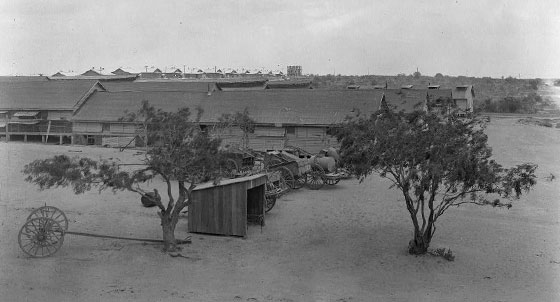Ringgold Barracks
Atop a river bluff from which two nations are visible, army engineers in 1848 established Camp Ringgold. After the U.S.-Mexican War, the Mexican government was forced to give up its claims to territory in Texas and the Southwest. Acting upon Mexican requests, the U.S. Army built forts along the Rio Grande from Brownsville to Eagle Pass. Camp Ringgold, later Ringgold Barracks, was named for Major Samuel Ringgold, who was killed at the battle of Palo Alto in 1846. Nearby stood the settlement of Rancho Davis, later renamed Rio Grande City. During the Civil War, Ringgold changed hands several times, starting in 1861when it was occupied by Confederate forces. Late in 1863, Union troops re-entered the Rio Grande Valley and seized the camp, only for it to be seized again by rebels led by Colonels John S. “Rip” Ford and Santos Benavides. Because of their efforts, the post stayed in Confederate hands until the end of the war. After 1865, the post was renamed Fort Ringgold and was updated with permanent brick buildings. African-American troops, including Civil War U.S. Colored Troops and later segregated African-American U.S. regulars (the so-called “Buffalo Soldiers”) were quartered here until the early twentieth century, protecting border communities from border unrest. As in Brownsville in 1906, black soldiers at Ringgold endured prejudice and discrimination that led to an outbreak of racial violence in 1899. In 1944, the army closed the historic fort when they sent the 124th Cavalry to Burma during World War II.
Listen
Ubicado sobre un repecho en la ribera del río desde el que ambos países resultan visibles, el campamento Ringgold fue establecido en 1848 por un cuerpo de ingenieros zapadores del ejército. Después de la guerra entre ambos países, conocida como Guerra de Intervención de EE.UU., el gobierno mexicano fue obligado a renunciar a sus reivindicaciones territoriales en Texas y el suroeste de lo que en la actualidad es Estados Unidos. A petición de la parte mexicana, el ejército estadounidense construyó diversos fuertes a lo largo del Río Grande, desde Brownsville hasta Eagle Pass. El campamento Ringgold, posteriormente conocido como «los barracones de Ringgold», se estableció en honor al mayor Samuel Ringgold, quien falleciera en la Batalla de Palo Alto en 1846. En las cercanías se encontraba el asentamiento del Rancho Davis, posteriormente denominado Río Grande City. Durante la Guerra de Secesión estadounidense, el emplazamiento cambió de manos en diversas ocasiones desde 1861, cuando fue ocupado por las fuerzas confederadas. A finales de 1863, las tropas unionistas incursionaron de nuevo en El Valle del Río Grande y tomaron el campamento, sólo para ser éste de nuevo ocupado por los rebeldes al mando de los coroneles John S. «Rip» Ford y Santos Benavides. Gracias a su esforzada resistencia, el baluarte continuó bajo bandera confederada hasta final de la guerra y, después de 1865, recibió la denominación de «Fuerte Ringgold», siendo remodelado con edificaciones permanente de ladrillo. En él se encontraron acuarteladas hasta principios del siglo XX unidades afroamericanas, entre las que se incluían El Regimiento Negro de la Unión durante la Guerra de Secesión estadounidense y, posteriormente, la fuerza regular afroamericana segregada (los denominados «soldados búfalo»), protegiendo desde allí a la comunidad fronteriza de las inestabilidades locales. Al igual que ocurriera en Brownsville en 1906, los soldados negros de Ringgold tuvieron que soportar prejuicios y discriminación, lo que condujo a un estallido de violencia racial en 1899. En 1944, el ejército clausuró este fuerte histórico cuando movilizó a Birmania el 124 de Caballería durante la Segunda Guerra Mundial.
Escucha
Details
Location: Fort Ringgold is located within the city limits of Rio Grande City, Texas, immediately east of the downtown historic district, on the south side of U.S. Highway 83.
Access: The former Fort Ringgold reservation is now the Administrative Campus of the Rio Grande City Independent School District. The fort is open for visitors daily, though vehicle access around the parade ground is restricted on weekdays. Visitors may drive into other areas of the former post.
Contact: For Fort Ringgold and the Robert E. Lee House Museum, contact Mrs. Adelina Villarreal at (956) 488-6036. Note: She is the ONLY contact person for the Robert E. Lee House Museum. She requests that tours of the museum be arranged at least 24 hours in advance.

